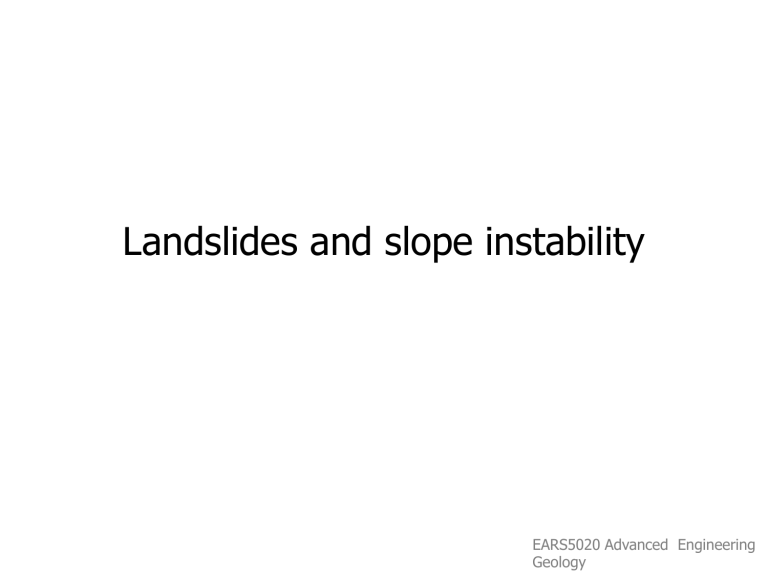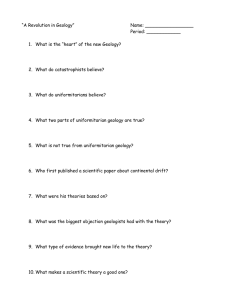Landslides & Slope Instability: Engineering Geology Presentation
advertisement

Landslides and slope instability EARS5020 Advanced Engineering Geology EARS5020 Advanced Engineering Geology What is a landslide • Landslide: refers to the downward sliding of huge. which occur along steep slopes of hills or mountains and may be sudden or slow.ass • Landslides are the physical expression of a group of processes which fall under the term of “mass movement” • the principal driving force for landslides is gravity and movement in down and outward. • landslides must have clearly defined boundaries involving only a limited portion of the hillslope. Landslide boundaries will occur at the top, bottom, sides and the base. EARS5020 Advanced Engineering Geology Landslides defined…. • Movement of a landslide must be moderately rapid and excludes creep. • Frozen ground phenomena are excluded. • Movement can include falling, bouncing, sliding or flow. • Movement can include soil or rock or some combination of the two EARS5020 Advanced Engineering Geology EARS5020 Advanced Engineering Geology EARS5020 Advanced Engineering Geology Why do landslides happen ? • Landslides occur when the stresses acting on a slope exceed the strength of the materials forming the slope. • forces along potential rupture surfaces exceed the forces resisting movement (i.e., cohesion, frictional) • Landslides can occur due to endogenic or exogenic processes. • while the principal force involved in movement is gravity landslides can be triggered by other events • common landslide triggering events are excessive rainfall, earthquakes and man. EARS5020 Advanced Engineering Geology Functional Relationships Relationships between driving force (weight) & resistance force (R) Resisting force (R) is proportional to shear strength of material (S) The main driving force is the Where shear strength or resistance (S) downslope component of the S = C + (sn -u) tan f weight (force) of the material The factors in S are: above the potential slip plane = W sin q where u = fluid pressure (pore water pressure) tan f = coefficient of internal friction f = angle of internal friction (frict. resist.) sn = normal stress (i.e., normal to surface or plane of discontinuity C = cohesion of material ----------------------------------------C and f depend on material type C, f, and u vary with water content W =Weight of material (above plane) q= angle of the plane (from horizontal) EARS5020 Advanced Engineering Geology Slope Stability • Forces on Slopes – Driving forces--tend to move material down slope Potential slip plane (clay). C D A N W • Weight of material ROCK (includes water)* • Vegetation D = W sin A = driving force • Fill material the downslope component of • Building loads gravity. EARS5020 Advanced Engineering Geology Slope Stability • Forces on Slopes – Resisting forces--forces that tend to resist movement • Shear strength Potential slip plane (clay). C N D A W ROCK N = W cos A = the normal component of W contributes to the shear strength along the slip plane contributes to the resisting force. EARS5020 Advanced Engineering Geology Some Implications, Relationships • The steeper the angle of inclination from horizontal, the larger the shear stress • Decreases in S less strength, i.e., less force is required to cause a rupture • C and q have different values for: – different types of soil or rock materials – dry materials vs. wet materials • Angles of frictional resistence (q) of dry rock materials vary from q >40o for some igneous rocks, to q = 10o-20o for clay. • For materials like soil and clay-rich rocks, q can be smaller by a factor of 2 for saturated conditions EARS5020 Advanced Engineering Geology Factors Resulting in Decreased Slope Stability • Increased pore pressure (affects sn); e.g., Storms, fluctuating groundwater • Increased water content (reduces C, q) • Steepening of slopes (affects sn) • Loading of slopes (affects sn) • Earthquake shaking (reduces C, q) • Removal of material from the base of slopes (Directly reduces S) – Rivers, waves, man • Changes in vegetation • Change in chemical composition of pore EARS5020 Advanced water Geology Engineering EARS5020 Advanced Engineering Geology Classification Schemes EARS5020 Advanced Engineering Geology Classification of landslides (after EARS5020 Advanced Engineering Varnes, Geology 1977) EARS5020 Advanced Engineering Geology EARS5020 Advanced Engineering Geology EARS5020 Advanced Engineering Geology EARS5020 Advanced Engineering Geology Landslide classification Landslides can be classified on the basis of: • Type of movement • rate of movement • age of movement EARS5020 Advanced Engineering Geology Landslide classification - material and movement type (Varnes, 1978) EARS5020 Advanced Engineering Geology Falls • Falls are abrupt movements of masses of geologic materials, such as rocks and boulders, that become detached from steep slopes or cliffs. • Separation occurs along discontinuities such as fractures, joints, and bedding planes. • movement occurs by free-fall, bouncing, and rolling. • Falls are strongly influenced by gravity, mechanical weathering, and the presence of interstitial water. EARS5020 Advanced Engineering Geology Topple • Toppling failures are distinguished by the forward rotation of a unit or units about some pivotal point, below or low in the unit, under the actions of gravity and forces exerted by adjacent units or by fluids in cracks. EARS5020 Advanced Engineering Geology Can be true ‘falls’ or can be ‘topples’ depending on the size and orientation of the joint blocks (images courtesy of Eddie Bromhead and Oldrich Hungr) EARS5020 Advanced Engineering Geology EARS5020 Advanced Engineering Geology EARS5020 Advanced Engineering Geology Left: Block topple at the crown of the Stambach Landslide, Austria. Below: flexural toppling EARS5020 Advanced Engineering Geology Problematic landslides… are they rock or are they ‘debris’ ? Left: a ‘disrupted’ rockslide in Taroko Gorge, Taiwan. EARS5020 Advanced Engineering Geology Slides Rotational and Translational EARS5020 Advanced Engineering Geology Rotational slide • This is a slide in which the surface of rupture is curved concavely upward and the slide movement is roughly rotational about an axis that is parallel to the ground surface and transverse across the slide. EARS5020 Advanced Engineering Geology Translational slide • the landslide mass moves along a roughly planar surface with little rotation or backward tilting. • A block slide is a translational slide in which the moving mass consists of a single unit or a few closely related units that move downslope as a relatively coherent mass EARS5020 Advanced Engineering Geology Landslide classification - material and movement type (Varnes, 1978) EARS5020 Advanced Engineering Geology The Vaiont landslide - large rock slide on a planar discontinuity (photo courtesy of Eddie Bromhead) EARS5020 Advanced Engineering Geology The Vaiont Dam Disaster • Date: October 9, 1963 • Casualties: c. 2000 deaths and the towns of Longarone and Villanova in the Piave Valley were destroyed. • Background: The Vaiont Dam was constructed in a high valley in the Italian Alps Piave River in 1959-1960 and was 266 meters tall, making it the world’s second highest dam. • Geology: Limestones of Cretaceous age with strong rock materials and a good-very good quality rock mass. There was evidence of unloading fractures parallel to the valley sides. EARS5020 Advanced Engineering Geology • Sequence of events: As the reservoir began to reach its planned level a large tension crack opened, up to 300 m wide and 1.5 m high. • Heavy rainfall led to reactivation of initial movement. Rapid drawdown of the water level in an attempt to control the landslide, which was moving at rates of up to 0.4m per day failed. The last measurements on the 9th of October indicated a rate of 80 cm per day over a large area. • On October 9 at about 10:15 pm the landslide accelerated. A large block 2 km long, 1.5 km wide, and several hundred meters thick slipped (2.7x108m3) down the mountainside into the reservoir. The resultant wave overtopped the reservoir by 70m flooding the towns below (Villanova, Longarone and Casso). EARS5020 Advanced Engineering Geology Geological cross section of the Vaiont Landslide (reproduced from Herndon and Patton, 1985). EARS5020 Advanced Engineering Geology • A large number of two-dimensional limit equilibrium analyses using methods of slices were performed after the failure by various investigators. • The friction angles required for stability back-calculated from these analyses range from f = 17.5° to f = 28°. However, strength test data on the clay material along the failure surface show friction angles ranging from 5° to 16°, with an average value c. 12° (Hendron and Patton, 1985). • On the basis of these values the slope should not have been stable prior to impounding the reservoir. EARS5020 Advanced Engineering Geology Left: the Vaiont dam 1963 Below: the Piave Valley before the disaster EARS5020 Advanced Engineering Geology The Piave valley: after the landslide EARS5020 Advanced Engineering Geology Damage to a car park in Lyme Regis by a shallow rotational slide (note the stem bends in the trees and the ‘toe’ heave. EARS5020 Advanced Engineering Geology Left: a translational landslide affecting a motorway near the town of Calitri in Southern Italy. Note the road section to the right of the photograph which shows no back-tilted rotation indicating that the landslide is translational (i.e. a planar shear surface) and not a rotational slide (i.e. a circular shear surface). EARS5020 Advanced Engineering Geology Flow slides EARS5020 Advanced Engineering Geology Types of flow There are five basic categories of flows that differ from one another in fundamental ways. • Debris flow • Debris avalanche • Earthflow • Mudflow • Creep EARS5020 Advanced Engineering Geology Debris flow • A debris flow is a form of rapid mass movement in which a combination of loose soil, rock, organic matter, air, and water mobilize as a slurry that flows downslope. • Debris flows include <50% fines. • Debris flows are commonly caused by intense surface-water flow, due to heavy precipitation or rapid snowmelt, that erodes and mobilizes loose soil or rock on steep slopes. • Debris flows also commonly mobilize from other types of landslides that occur on steep slopes, are nearly saturated, and consist of a large proportion of silt- and sand-sized material. EARS5020 Advanced Engineering Geology Debris avalanche • This is a variety of very rapid to extremely rapid debris flow. EARS5020 Advanced Engineering Geology Earthflow • Earthflows have a characteristic "hourglass" shape. • The slope material liquefies and runs out, forming a bowl or depression at the head. • The flow itself is elongate and usually occurs in fine-grained materials or clay-bearing rocks on moderate slopes and under saturated conditions. • However, dry flows of granular material are also possible. EARS5020 Advanced Engineering Geology Mudflow • A mudflow is an earthflow consisting of material that is wet enough to flow rapidly and that contains at least 50 percent sand-, silt-, and clay-sized particles. • In some instances, for example in many newspaper reports, mudflows and debris flows are commonly referred to as "mudslides." EARS5020 Advanced Engineering Geology Creep • Creep is the imperceptibly slow, steady, downward movement of slope-forming soil or rock. • Movement is caused by shear stress sufficient to produce permanent deformation, but too small to produce shear failure. • There are generally three types of creep (1) seasonal, where movement is within the depth of soil affected by seasonal changes in soil moisture and soil temperature. (2) continuous, where shear stress continuously exceeds the strength of the material (3) progressive, where slopes are reaching the point of failure as other types of mass movements. Creep is indicated by curved tree trunks, bent fences or retaining walls, tilted poles or fences, and small soil ripples or ridges EARS5020 Advanced Engineering Geology Landslide classification - material and movement type (Varnes, 1978) EARS5020 Advanced Engineering Geology EARS5020 Advanced Engineering Geology Above: a false colour infra red image of the Black Ven landslide complex from April 1994. The blue colours indicate clay rich Liassic rocks, the greenbrown colours indicate water-rich landslide debris. EARS5020 Advanced Engineering Geology EARS5020 Advanced Engineering Geology EARS5020 Advanced Engineering Geology EARS5020 Advanced Engineering Geology



